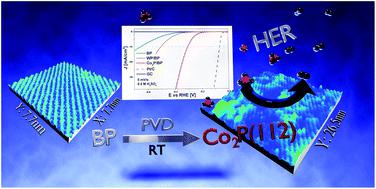当前位置:
X-MOL 学术
›
Inorg. Chem. Front.
›
论文详情
Our official English website, www.x-mol.net, welcomes your
feedback! (Note: you will need to create a separate account there.)
Interfacial chemistry and electroactivity of black phosphorus decorated with transition metals
Inorganic Chemistry Frontiers ( IF 6.1 ) Pub Date : 2020-11-16 , DOI: 10.1039/d0qi01097a Tomasz Kosmala 1, 2, 3, 4 , Luca Bardini 1, 2, 3, 4 , Maria Caporali 4, 5, 6, 7 , Manuel Serrano-Ruiz 4, 5, 6, 7 , Francesco Sedona 1, 2, 3, 4 , Stefano Agnoli 1, 2, 3, 4 , Maurizio Peruzzini 4, 5, 6, 7 , Gaetano Granozzi 1, 2, 3, 4
Inorganic Chemistry Frontiers ( IF 6.1 ) Pub Date : 2020-11-16 , DOI: 10.1039/d0qi01097a Tomasz Kosmala 1, 2, 3, 4 , Luca Bardini 1, 2, 3, 4 , Maria Caporali 4, 5, 6, 7 , Manuel Serrano-Ruiz 4, 5, 6, 7 , Francesco Sedona 1, 2, 3, 4 , Stefano Agnoli 1, 2, 3, 4 , Maurizio Peruzzini 4, 5, 6, 7 , Gaetano Granozzi 1, 2, 3, 4
Affiliation

|
Black phosphorus (BP) exhibits a significant chemical reactivity toward transition metals, which is strongly dependent on its electronic and morphological features. Using as a case study metal Co atoms deposited by physical vapor deposition on chemically exfoliated BP thin films, we document that environmentally oxidized BP edges react immediately with the formation of Co(II)–POx species, but later also the basal plane strongly reacts, already at room temperature, to form an interfacial phosphide. Atomically resolved scanning tunneling microscopy data reveal the formation of a Co2P(112) layer, upon which the further growth of metal Co nanoparticles takes place. X-ray photoemission spectroscopy data show similar interfacial reactions also for atomic W, suggesting a quite general behavior. The electrochemical and photoelectrocatalytic properties of the resulting metal–BP nanohybrids are investigated by linear sweep voltammetry and electrochemical impedance spectroscopy. The Co–BP nanohybrid shows a marked stability in acid media and a significant increase of the electrocatalytic activity for the hydrogen evolution reaction with respect to bare BP, due to the formation of a very stable phosphide phase, and even an interesting photoactivity connected to the formation of p–n junction between BP and Co2P. On the other hand, the W–BP nanohybrid exhibits a modest performance in the electrocatalytic production of hydrogen because of the formation of less active oxide phases as a consequence of environmental oxidation.
中文翻译:

过渡金属修饰的黑磷的界面化学和电活性
黑磷(BP)对过渡金属表现出显着的化学反应性,这在很大程度上取决于其电子和形态特征。作为案例研究,通过物理汽相沉积在化学剥落的BP薄膜上沉积的金属Co原子,我们证明了环境氧化的BP边缘会立即与Co(II)-PO x物种的形成发生反应,但随后基面也会强烈反应已经在室温下形成界面磷化物。原子分辨扫描隧道显微镜数据揭示了Co 2的形成P(112)层,在其上发生金属Co纳米颗粒的进一步生长。X射线光电子能谱数据也显示了原子W的相似界面反应,表明行为相当普遍。通过线性扫描伏安法和电化学阻抗谱研究了所得金属-BP纳米杂化物的电化学和光电催化性能。Co-BP纳米杂化物在酸性介质中显示出显着的稳定性,并且相对于裸露的BP而言,显着提高了对氢气析出反应的电催化活性,这是由于形成了非常稳定的磷化物相,甚至还存在与之相关的有趣的光活性。 BP和Co 2之间形成p–n结P.另一方面,W-BP纳米杂化物在氢的电催化生产中表现出适度的性能,因为由于环境氧化而形成的活性较低的氧化物相。
更新日期:2020-12-17
中文翻译:

过渡金属修饰的黑磷的界面化学和电活性
黑磷(BP)对过渡金属表现出显着的化学反应性,这在很大程度上取决于其电子和形态特征。作为案例研究,通过物理汽相沉积在化学剥落的BP薄膜上沉积的金属Co原子,我们证明了环境氧化的BP边缘会立即与Co(II)-PO x物种的形成发生反应,但随后基面也会强烈反应已经在室温下形成界面磷化物。原子分辨扫描隧道显微镜数据揭示了Co 2的形成P(112)层,在其上发生金属Co纳米颗粒的进一步生长。X射线光电子能谱数据也显示了原子W的相似界面反应,表明行为相当普遍。通过线性扫描伏安法和电化学阻抗谱研究了所得金属-BP纳米杂化物的电化学和光电催化性能。Co-BP纳米杂化物在酸性介质中显示出显着的稳定性,并且相对于裸露的BP而言,显着提高了对氢气析出反应的电催化活性,这是由于形成了非常稳定的磷化物相,甚至还存在与之相关的有趣的光活性。 BP和Co 2之间形成p–n结P.另一方面,W-BP纳米杂化物在氢的电催化生产中表现出适度的性能,因为由于环境氧化而形成的活性较低的氧化物相。











































 京公网安备 11010802027423号
京公网安备 11010802027423号